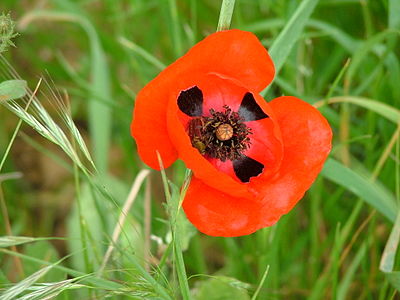Commons:Featured picture candidates/File:Semitic Poppy 01.jpg
Jump to navigation
Jump to search
File:Semitic Poppy 01.jpg, not featured
[edit]Voting period is over. Please don't add any new votes.Voting period ends on 27 Apr 2013 at 20:07:11 (UTC)
Visit the nomination page to add or modify image notes.
 Info A Semitic Poppy (Papaver umbonatum) in the Nataf area. Created, uploaded and nominated by SuperJew
Info A Semitic Poppy (Papaver umbonatum) in the Nataf area. Created, uploaded and nominated by SuperJew Support -- SuperJew (talk) 20:07, 18 April 2013 (UTC)
Support -- SuperJew (talk) 20:07, 18 April 2013 (UTC) Oppose -- The red channel is blown. A common problem with many flowers! -- Alvesgaspar (talk) 21:45, 18 April 2013 (UTC)
Oppose -- The red channel is blown. A common problem with many flowers! -- Alvesgaspar (talk) 21:45, 18 April 2013 (UTC)
 Question I didn't understand your meaning. Can you explain what you mean more simply for me please? --SuperJew (talk) 06:22, 19 April 2013 (UTC)
Question I didn't understand your meaning. Can you explain what you mean more simply for me please? --SuperJew (talk) 06:22, 19 April 2013 (UTC)
- The JPG records levels of red, green and blue for each pixel in numbers between 0 and 255. The mix of these gives all the colours of the JPG. If an image gets over-exposed then the numbers hit 255 and no tonal variation is seen. Often all three colours get "blown" and you see pure white. But sometimes just one colour (channel) is blown. In this case, red. Some image programs let you see a histogram of the range of colour levels in an image. See this link for an online alternative (you may have to click the link below the image to see the histogram). You will see that the red channel has peak at the far right of the histogram indicating a lot of pixels have 255 for red. There's not much one can do if the camera saves a JPG other than to take it again with a lower exposure if possible. Photographing on an overcast day rather than bright sunlight can also help as this lowers the range of brightess, keeping things within the range the camera can cope with. If using a DSLR and outputting RAW files, then there is a little more scope to rescue things, but not a lot. Colin (talk) 08:00, 19 April 2013 (UTC)
 Question Ok, so how does this make this specific picture less good? Looking at this picture doesn't seem to me as if this "blown" channel affects the quality --SuperJew (talk) 08:11, 19 April 2013 (UTC)
Question Ok, so how does this make this specific picture less good? Looking at this picture doesn't seem to me as if this "blown" channel affects the quality --SuperJew (talk) 08:11, 19 April 2013 (UTC)
- There isn't as much tonal variation as if the image were better exposed. The veins and surface texture are lost. Colin (talk) 10:14, 19 April 2013 (UTC)
- The JPG records levels of red, green and blue for each pixel in numbers between 0 and 255. The mix of these gives all the colours of the JPG. If an image gets over-exposed then the numbers hit 255 and no tonal variation is seen. Often all three colours get "blown" and you see pure white. But sometimes just one colour (channel) is blown. In this case, red. Some image programs let you see a histogram of the range of colour levels in an image. See this link for an online alternative (you may have to click the link below the image to see the histogram). You will see that the red channel has peak at the far right of the histogram indicating a lot of pixels have 255 for red. There's not much one can do if the camera saves a JPG other than to take it again with a lower exposure if possible. Photographing on an overcast day rather than bright sunlight can also help as this lowers the range of brightess, keeping things within the range the camera can cope with. If using a DSLR and outputting RAW files, then there is a little more scope to rescue things, but not a lot. Colin (talk) 08:00, 19 April 2013 (UTC)
 Oppose Detail is lost for the reason explained above and due to noise and noise reduction. Not even QI for me. --Julian H. (talk/files) 14:55, 19 April 2013 (UTC)
Oppose Detail is lost for the reason explained above and due to noise and noise reduction. Not even QI for me. --Julian H. (talk/files) 14:55, 19 April 2013 (UTC)
Confirmed results:
Result: 1 support, 2 oppose, 0 neutral → not featured. /George Chernilevsky talk 21:25, 24 April 2013 (UTC)
